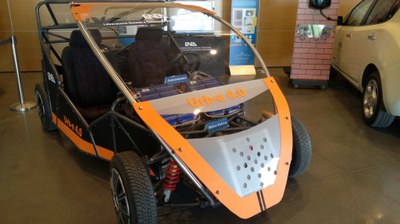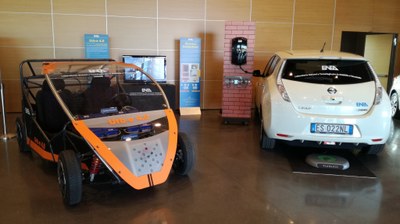Mobility: Urb-e 4.0, the new hybrid city car by ENEA
7/12/2017
Urb-e 4.0 is the latest hybrid city car prototype developed by ENEA. Originally designed as a simple system working as a test bench for the development of future management strategies of the thermal motor-generator and electricity storage, with a pure electric driving mode, on board generator and energy storage system, the prototype became the starting point for optimizing other engine types.
 Urb-e 4.0 is the last generation (the fourth): after the first petrol hybrid version and the pure electric version with lead batteries and supercondensators, then again pure electric with lithium-ion batteries, here comes a hybrid car that works with hydrogen powered fuel cell.
Urb-e 4.0 is the last generation (the fourth): after the first petrol hybrid version and the pure electric version with lead batteries and supercondensators, then again pure electric with lithium-ion batteries, here comes a hybrid car that works with hydrogen powered fuel cell.
Urb-e 4.0 has a battery recharged during stops by a very small 1kW fuel cell capable of generating electric energy thanks to the hydrogen contained in two 10 litres cylinders. Recharging takes no more than four hours and once empty the cylinders can be replaced at a gas station or an equipped area, making it possible to use an electric car even in absence of a garage and with long charging intervals.
A modification to the management software is being developed to allow the fuel cell, when running at a constant speed, to directly power the electric traction motor, avoiding battery losses and with a 20% efficiency recovery.
This high-performance vehicle is the answer to the need for developing an electric powertrain independent from a charging point in a garage or guarded parking for overnight charge or during working hours, conditions still difficult to guarantee and hindering widespread adoption of electric cars. A dynamic wireless charging system currently under development, specifically developed to make it easier to charge and increase safety of operations, due to the absence of contact between the vehicle and the grid, will be tested by Urb-e 4.0.
 Urbe 4.0, a zero emission city car, by trying to overcome the problems related to charging and a short autonomy range, factors which have always hindered the diffusion of electric and hybrid cars, has provided an answer to these limits, surpassing both the pure electric ( which has the limit of a high power to weight ratio, hence the higher the autonomy the heavier and larger the battery, up to a point where is counterproductive having a high capacity battery since its weight consumes its autonomy), and the pure hydrogen (more expensive) by proposing a combination of both technologies. The hydrogen cell guarantees autonomy without a significant increase of weight because the battery can be small.
Urbe 4.0, a zero emission city car, by trying to overcome the problems related to charging and a short autonomy range, factors which have always hindered the diffusion of electric and hybrid cars, has provided an answer to these limits, surpassing both the pure electric ( which has the limit of a high power to weight ratio, hence the higher the autonomy the heavier and larger the battery, up to a point where is counterproductive having a high capacity battery since its weight consumes its autonomy), and the pure hydrogen (more expensive) by proposing a combination of both technologies. The hydrogen cell guarantees autonomy without a significant increase of weight because the battery can be small.
The Urban easy, specifically designed for urban use, has a top speed of 80 km/h and a range of about 70 km per charge with 2 hydrogen cylinders (0.3 kg), ( at the moment it has only one). With a possible additional charge of the battery from the grid the autonomy reaches over 100 km. “Currently, an actual retail sale of hydrogen cylinders is not available in Italy, but it’s a feasible marketing, as in the United States, where over 6thousand forklifts used in supermarkets are hydrogen powered” Giovanni Pede, Head of the ENEA Laboratory “Systems and Technologies for Mobility and Storage” pointed out.
How much does it cost to charge Urb-e 4.0? For an accurate estimate of costs and considering and additional battery charge from the grid, is necessary to calculate the cost of 4kW for the first charge of the battery (around 4 euro) and add the cost of 0.3 kg of hydrogen, which is of approximately 3 euro ( € 9,50/kg).
To sum up, travelling 130 km with Urb-e 4.0 would cost 4 euro.
With its low consumption and reduced environmental impact (a hydrogen fuel cell doesn’t produce neither particulate matters nor nitrogen oxide) Urb-e 4.0 takes up one of the major challenges facing sustainable mobility
| Series hybrid architecture with the possibility of adopting different systems according to the experimental needs |
| Technological demonstrator for the development and testing of innovative powerpacks |
| 1kW net power fuel cell generator |
| Electric storage system: a 48 V/ 80 lithium-ion battery |
| Drive: synchronous electric motor with a peak power of 15 kW |
For more information please contact:
Giovanni Pede, Head ENEA Laboratory for Systems and Technologies for Mobility and Storage, giovanni.pede@enea.it
Stephen McPhail, ENEA Laboratory for the Development of Chemical, Thermal and Fluid Dynamic Processes for Energy, stephen.mcphail@enea.it
